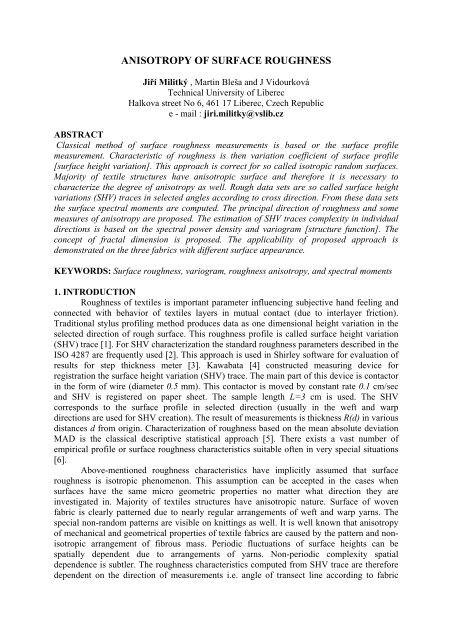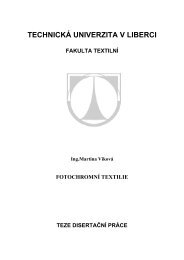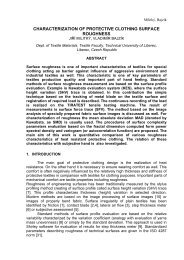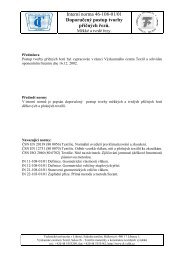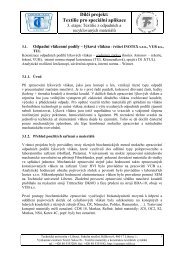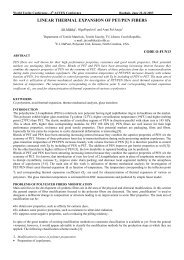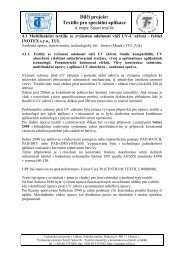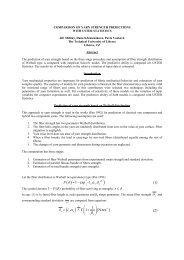ANISOTROPY OF SURFACE ROUGHNESS - Centrum Textil
ANISOTROPY OF SURFACE ROUGHNESS - Centrum Textil
ANISOTROPY OF SURFACE ROUGHNESS - Centrum Textil
You also want an ePaper? Increase the reach of your titles
YUMPU automatically turns print PDFs into web optimized ePapers that Google loves.
<strong>ANISOTROPY</strong> <strong>OF</strong> <strong>SURFACE</strong> <strong>ROUGHNESS</strong>Jiří Militký , Martin Bleša and J VidourkováTechnical University of LiberecHalkova street No 6, 461 17 Liberec, Czech Republice - mail : jiri.militky@vslib.czABSTRACTClassical method of surface roughness measurements is based or the surface profilemeasurement. Characteristic of roughness is then variation coefficient of surface profile[surface height variation]. This approach is correct for so called isotropic random surfaces.Majority of textile structures have anisotropic surface and therefore it is necessary tocharacterize the degree of anisotropy as well. Rough data sets are so called surface heightvariations (SHV) traces in selected angles according to cross direction. From these data setsthe surface spectral moments are computed. The principal direction of roughness and somemeasures of anisotropy are proposed. The estimation of SHV traces complexity in individualdirections is based on the spectral power density and variogram [structure function]. Theconcept of fractal dimension is proposed. The applicability of proposed approach isdemonstrated on the three fabrics with different surface appearance.KEYWORDS: Surface roughness, variogram, roughness anisotropy, and spectral moments1. INTRODUCTIONRoughness of textiles is important parameter influencing subjective hand feeling andconnected with behavior of textiles layers in mutual contact (due to interlayer friction).Traditional stylus profiling method produces data as one dimensional height variation in theselected direction of rough surface. This roughness profile is called surface height variation(SHV) trace [1]. For SHV characterization the standard roughness parameters described in theISO 4287 are frequently used [2]. This approach is used in Shirley software for evaluation ofresults for step thickness meter [3]. Kawabata [4] constructed measuring device forregistration the surface height variation (SHV) trace. The main part of this device is contactorin the form of wire (diameter 0.5 mm). This contactor is moved by constant rate 0.1 cm/secand SHV is registered on paper sheet. The sample length L=3 cm is used. The SHVcorresponds to the surface profile in selected direction (usually in the weft and warpdirections are used for SHV creation). The result of measurements is thickness R(d) in variousdistances d from origin. Characterization of roughness based on the mean absolute deviationMAD is the classical descriptive statistical approach [5]. There exists a vast number ofempirical profile or surface roughness characteristics suitable often in very special situations[6].Above-mentioned roughness characteristics have implicitly assumed that surfaceroughness is isotropic phenomenon. This assumption can be accepted in the cases whensurfaces have the same micro geometric properties no matter what direction they areinvestigated in. Majority of textiles structures have anisotropic nature. Surface of wovenfabric is clearly patterned due to nearly regular arrangements of weft and warp yarns. Thespecial non-random patterns are visible on knittings as well. It is well known that anisotropyof mechanical and geometrical properties of textile fabrics are caused by the pattern and nonisotropicarrangement of fibrous mass. Periodic fluctuations of surface heights can bespatially dependent due to arrangements of yarns. Non-periodic complexity spatialdependence is subtler. The roughness characteristics computed from SHV trace are thereforedependent on the direction of measurements i.e. angle of transect line according to fabric


